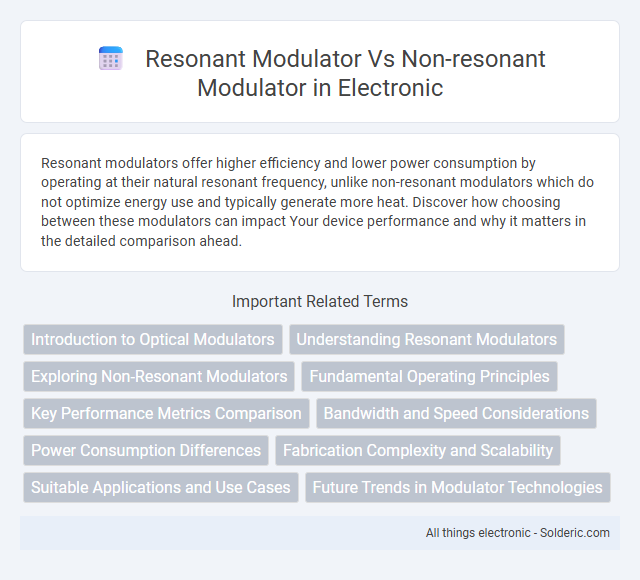Resonant modulators offer higher efficiency and lower power consumption by operating at their natural resonant frequency, unlike non-resonant modulators which do not optimize energy use and typically generate more heat. Discover how choosing between these modulators can impact Your device performance and why it matters in the detailed comparison ahead.
Comparison Table
| Feature | Resonant Modulator | Non-Resonant Modulator |
|---|---|---|
| Operating Principle | Uses a resonant circuit to enhance modulation efficiency | Direct modulation without resonance enhancement |
| Modulation Efficiency | Higher efficiency due to energy buildup in resonance | Lower efficiency, energy not stored/recycled |
| Bandwidth | Narrower bandwidth, frequency selective | Wider bandwidth, more flexible frequency response |
| Power Consumption | Typically lower due to resonant energy recycling | Higher power consumption |
| Complexity | More complex design with tuning requirements | Simpler design, easier implementation |
| Applications | High-efficiency microwave and RF communication | Broadband modulators in general-purpose use |
| Linearity | Improved linearity around resonant frequency | Variable linearity, depending on design |
Introduction to Optical Modulators
Optical modulators control light properties such as amplitude, phase, or frequency to encode information in optical communication systems. Resonant modulators leverage cavity resonance to enhance modulation efficiency and reduce power consumption, offering higher modulation depth and speed compared to non-resonant modulators, which rely on direct changes in refractive index or absorption without resonance effects. Your choice between resonant and non-resonant modulators impacts system performance, integration complexity, and energy efficiency in photonic circuits.
Understanding Resonant Modulators
Resonant modulators utilize specialized circuits that operate at specific resonant frequencies, enhancing energy efficiency and signal quality by minimizing power loss during modulation processes. Non-resonant modulators lack such frequency-specific tuning, often resulting in broader bandwidth but lower efficiency and higher heat dissipation. Understanding resonant modulators involves analyzing their role in improving performance in RF and optical communication systems through selective frequency amplification and reduced distortion.
Exploring Non-Resonant Modulators
Non-resonant modulators offer a broader bandwidth and simpler design compared to resonant modulators, making them ideal for applications requiring wide frequency ranges and rapid signal changes. These modulators avoid the narrow frequency limitation inherent in resonant types, providing greater flexibility for Your communication or signal processing needs. While resonant modulators optimize efficiency at specific frequencies, non-resonant modulators excel in versatility and robustness across diverse operating conditions.
Fundamental Operating Principles
Resonant modulators utilize LC tank circuits to achieve selective frequency amplification, enabling efficient modulation with reduced power loss by storing and releasing energy at a specific resonant frequency. Non-resonant modulators operate without frequency-selective components, relying on direct modulation techniques that typically consume more power and generate broader spectral content. The fundamental difference lies in the resonant modulator's energy-efficient frequency tuning versus the broader, less efficient modulation of the non-resonant counterpart.
Key Performance Metrics Comparison
Resonant modulators typically offer higher energy efficiency and faster switching speeds compared to non-resonant modulators, due to their ability to leverage resonance phenomena for selective frequency operation. Non-resonant modulators provide broader bandwidth and simpler design architectures but tend to consume more power and exhibit higher insertion loss. Your choice between the two depends on the priority of metrics such as modulation speed, energy consumption, and operational bandwidth for your specific application.
Bandwidth and Speed Considerations
Resonant modulators offer narrower bandwidth but higher speed due to their selective frequency response, making them ideal for applications requiring low power consumption and precise modulation. Non-resonant modulators provide broader bandwidth, enabling faster data transmission over a wider range of frequencies but typically at the cost of increased power usage and potential signal distortion. Your choice between resonant and non-resonant modulators should balance the need for speed versus bandwidth based on the specific performance requirements of your photonic system.
Power Consumption Differences
Resonant modulators typically exhibit lower power consumption compared to non-resonant modulators due to their ability to recycle energy within the resonant circuit, reducing the need for continuous external power input. Non-resonant modulators rely on constant driving signals that often result in higher energy dissipation and heat generation. Optimizing your system with resonant modulators can improve overall energy efficiency and reduce operational costs significantly.
Fabrication Complexity and Scalability
Resonant modulators require precise fabrication techniques due to their dependence on high-quality factor resonators, which often involves complex lithography and tighter process control, potentially limiting scalability in large-scale production. Non-resonant modulators feature simpler structures that are easier to manufacture, enabling more straightforward scaling and lower fabrication costs. Your choice between the two impacts manufacturing efficiency and the feasibility of mass production in photonic integrated circuits.
Suitable Applications and Use Cases
Resonant modulators excel in high-frequency applications such as RF communication systems and radar, where energy efficiency and low power loss are critical, making them ideal for mobile devices and satellite communications. Non-resonant modulators are preferred in applications demanding wide bandwidth and fast switching speeds like digital signal processing and optical modulators, supporting high-speed data transmission in fiber-optic networks. The choice between resonant and non-resonant modulators depends on the specific requirements for power efficiency, frequency range, and modulation speed in each use case.
Future Trends in Modulator Technologies
Future trends in modulator technologies emphasize the shift towards resonant modulators due to their superior energy efficiency and enhanced signal quality compared to non-resonant modulators. Resonant modulators leverage high-Q circuits to minimize power dissipation and support higher modulation speeds, making them ideal for next-generation communication systems and photonic applications. Your choice in modulator technology will increasingly favor resonant designs as demand grows for ultra-fast, low-power data transmission in 5G, IoT, and integrated photonics.
Resonant modulator vs non-resonant modulator Infographic

 solderic.com
solderic.com